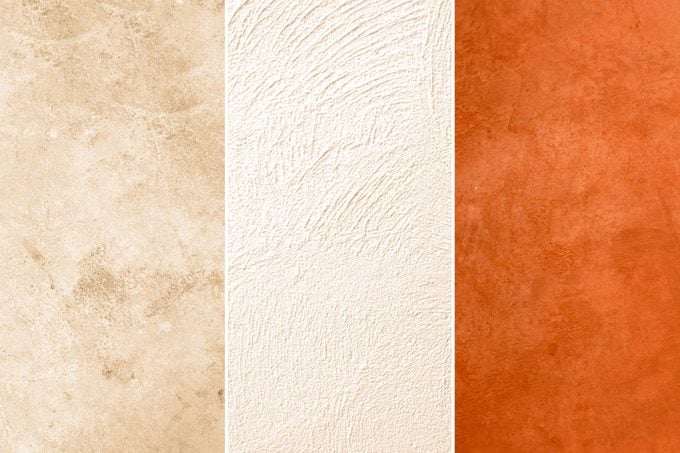What To Know About Textured Paint
Is sponge paint making a big comeback? Not exactly. Read on to find out what is.
When you hear the term “textured paint,” you may be thinking about — and cue the horror movie soundtrack here — sponge paint or popcorn ceilings, which we know you don’t care to revisit. That’s not what we mean here.
But there are rumblings that textured paints — or, to other pros, specialty wall finishes — are back on the rise. In particular, you may have heard about or seen images of limewash, Roman clay, or microcement as trending wall finishes that may nevertheless be sometimes categorized as textured paint.
We’re here to demystify!
On This Page
What Is Textured Paint?
According to Ashley Daubert, interior designer for Beam, textured paint can include additives such as sand particles that add grit, enhancing the texture of the walls. But it doesn’t have to be additives; it can also be the techniques used. A painter can apply regular paint with a trowel to achieve different patterns, or spray the walls and then apply paint on top to create texture.
For DIYers new to this, paint rollers with textured patterns can help easily achieve a similar professional effect. Daubert’s colleague Liv Buli, the head of content at Beam, draws a finer line.
“Personally, I think specialty wall finishes such as lime wash, Roman clay, microcement and tadelakt are trending versus a textured paint,” she says.
“Although there are paints and application processes that can create a faux plaster look, perhaps if someone doesn’t have the budget for the real thing, they are looking into the faux options. Regardless, texture in any medium is trending! Even in wall coverings and fabrics.”
Jason Smith, regional manager of Precision Painting Plus, likens textured paint to mixing a cake. “You have pigment, which is like the flour,” he says. “Eggs are the resin, or the glue that binds everything together. And milk or water is the third main ingredient — in this case, the textured finishes.”
Textured paints, he says, have additives such as silica sand. Or additives can be implied in the way another chemical dilutes the paint. He’s seen the biggest — and maybe only — uptick in this category with limewash.
Types of Textured Paint
There are a few ways to get textured paint, Smith says.
- Premixed: These come looking like a can of paint. You buy it off the shelf, pop the top and paint it on.
- Mix-ins: These are powders you add water to, then add to the paint, changing its texture. Then you apply the paint to the wall.
- Aggregates/Additives: “These you can add yourself at [The] Home Depot or [a} Benjamin Moore store, for example,” he says. “You’ll buy a container of silica sand or mica flakes and dump them into the can.”
These are all mostly based on latex paints, not oil-based, since those are a “different and kind of dying breed,” Smith says. But, he says, if you decide to go the oil-based paint route, you’ll need a paddle or drill mixer to get the consistent finish you’re looking for. “Handmixing won’t disperse the aggregate accordingly,” he says.
Textured Paint Finishes
According to Daubert, there are a few finishes you may see with textured paints.
- Smooth texture: Uses thicker paint without any aggregates. Applied with a putty knife to look like plaster.
- Sand texture: Uses sand as an aggregate mixed in with the paint. Varying sizes of grains can change the finished look.
- Knockdown texture: Involves spraying a thick layer of paint. After that has dried, the high points are knocked down and spread by a putty knife or trowel.
- Slap brush: Technique using paint applied in sweeping, brushing and twisting motions to achieve a texture and pattern.
Pros and Cons of Textured Paint
Pros of textured paint
- Hides imperfections on existing walls: That’s the one really big one. It can add a softness and warmth to the space that flat paint couldn’t achieve, Daubert says.
- Limewash brightens brick: Limewash will brighten and change the color of your brick while creating an artistic or natural finish, rather than a flat, static coat of paint. It can also warm up other textures and add dimension and visual interest.
- Application: “If you’re a pro DIYer, you’ll be able to do it no problem, with pretty good results,” Smith says. But if you typically shy away from paint DIY, hire a pro.
Cons of textured paint
- Design: Some textures can date the room. Limewash and Roman clay are different wall finishes that have a more timeless appearance, Daubert says. “As long as folks understand it is a trend, so more likely than not you’ll get tired of it and want to change it,” then go for it, says Smith.
- Cost: It’s a specialty finish and pros will expect top dollar, says Smith. It also takes more time, adding to the cost.
- Maintenance: Smith says maintenance on textured-paint walls is a double-edged sword. “If a textured finish or wall gets damaged, recreating that same texture will be almost impossible,” he says. “You’re looking at redoing the entire surface.” That means possibly even ripping out the drywall and starting fresh. But overall, maintenance is relative lower, because the texture likely will add additional durability. At the least, he says, if it’s applied properly and the surface is prepared correctly, it will last as long as any other paint product in your home.




